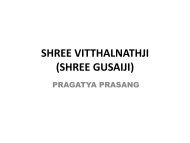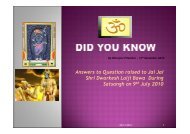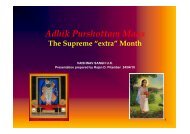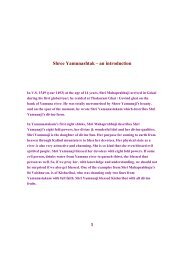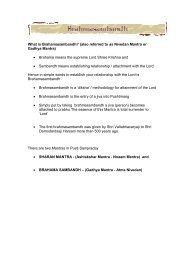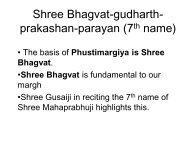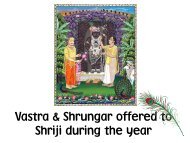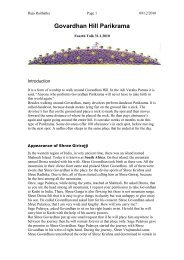View Document - VaishnavSangh.org.uk
View Document - VaishnavSangh.org.uk
View Document - VaishnavSangh.org.uk
- No tags were found...
Create successful ePaper yourself
Turn your PDF publications into a flip-book with our unique Google optimized e-Paper software.
• Saama Veda (1000) - Melodious hymns for praising divine forces for rituals, music. (Containsdetails of Gandharvaveda: singing, musical notes (raga, taal), instruments..)• Atharvana Veda (50) - Organising society, practical aspects of life, good health, spells, acquiringand managing material assets. (Contains numerous amazing and valuablesubjects like Ayurveda: health and healing, remedies, dietary info. etc..)ONLY 11 SAKHAS REMAIN TODAY IN KALIYUGA !!UPANISHADSMost significant and last (4 th) part of Vedas..the ESSENCE (1 ST Mantra Samihat (hymns), 2 nd Bhramans (riteritual), 3 rd Aranyakas (mystical meanings of rituals) The word Upanishad means to "sit near". Upa=near,Ni=below, Sad=sit down - That means the disciple or shishya sits near the guru, near his feet, and listens toan intimate session of spiritual instructions. This was the system of learning in the Vedic culture. Upanishadsare also called Vedanta – Veda anta - the ultimate knowledge.100+ of them, but Adi Shankaracharya says that there are 10 or 20 main Upanishads depending on whichbranch or sampradaya. Upanishads are commentary on Vedas . They are considered as Darshana "somethingseen" and the student has not only to listen but to realize them. These sessions were not casual like someseminar or workshop but the dedication of almost the whole life time. – Intellectual discussions, explanationsand practical answers.Just to quote from one of the Upanishads (Katha Upanishad) it says, “only a few hear these truths, ofthose who hear only a few understand, and of those only a handful attain the goal.” Lord Krishna alsosays in Bhagavad Gita like this to Arjuna. - [Recommended reading in Katha Upanishad: NACHIKETASTORY >> re: Yamaraja and questions about death and afterlife.]A desire to know something is the motivation behind all science, and in Vedic India this scientific traditionwas started long time ago and the roots of this scientific spirit are in Vedas and other scriptures emanatingfrom them. SHASTRA = means science: something presented with logic and scientific explanation.PURANAS - Extension of Vedas.Ancient History, stories of gods and goddesses, avatars, and Manu –. Information on manvantars (timeperiods), cosmology, teachings, ethics, rules, future predictions/prophecies.Vyasji created Puranas to explain in a simple language and entertaining way what is told in Vedas in a dryand complex style. Tales of sins and sacredness, duty and truancy, deeds and misdeeds.. of gods and kingsdynasties (Surya vansha, etc.). Parables to assimilate eternal truths applicable in all walks of life.Mahabharat and Ramayan are called ITTIHASA = “as it happened” = historical account as recordedYogis observing Veda mantras >> called Rishis (teachers)… and those practising mythological knowledgeand mantras from Purans are Munis (practicing sadhana).Total 18 Purans..e.g. Bhagvat, Narad, Vishnu, Shiva, Bhavishya, Bhramand(e.g. info. about different Tilaks)** (6 tamas, 6 rajas, 6 satvik) **PATHS OF SANATAN DHARMA – THE 3 ROADS TO THE FINAL TRUTHGyan Marg - KNOWLEDGE, MEDITATION, READINGKarma Marg -ACTION, POOJAS, YAGNAS, VRATASBhakti Marg - DEVOTION, LOVE OF GOD, IMPLICIT SURRENDERRajan D. Pitamber 27.09.09
• In Gyan marg a person realises his true self through knowledge and truth. This is said to be the mostdifficult of all as it is filled with many hurdles. Gyan marg is not possible for all since one needs anenlightened good Guru and devote lot of time. But for an educated person, having mental capacityGyan marg is preferred, as they can spread the light of Gyan jyothi into many Agyan people.**For the ANALYTICAL, INTELLECTUAL, ACADEMICALLY inclined.• Karma Marg The path of hard work, the journey in this path revolves around the work one does, hisactions. A person is known by the kind of karma he does and with the right karma he attains theeternal bliss. **For the MECHANICAL, DYNAMIC, PRAGMATICALLY inclined.• Bhakthi marg is for anyone.. it is just surrendering in totality..For a lay person Bhakti marg is thepreferred choice to reach God, if not in this birth, at least in future births. This path of Devotion iswhere one renounces everything and leaves everything to God. It is the easiest path and oneneeds to have faith in God to be able to walk this path. Faith is the driving factor, if one loses it hisbhakti is over. **For the EMOTIONAL, EVEN-TEMPERED, SENTIMENTALLY inclined.A mix of all these paths can lead one to the final truth. As without Gyan we would never know thefinal Truth, without Devotion we will not be able to Enjoy it, and without Karma we will not be able toAchieve it.BHAKTI is of two types:Maryada – limited to an extentFor attaining liberation (m<strong>uk</strong>ti), or for material benefits, through worship of other forms of gods/ goddesses.The devotee gives up worldly pleasures and dedicates complete life to worshipping deity of choice.Follows shastras, rituals, poojas. When the devotee becomes eligible, the deity gives liberation and thedevotee is freed of undergoing the cycle of life+birth forever.Pushti – grace filled, bountiful, overflowing loveDoes not limit itself to liberation, or material benefits. Liberation has no bliss in itself. The Ananda (bliss)aspect of Shri Krishna is what a Pushti devotee seeks through his devotion. This Ananda lies nowhere elsebut in Shri Krishna's Bhakti alone. Pusti Bhakti can never be practiced with expectation in return. Hence it iscalled "Bhait<strong>uk</strong>i", i.e. without a reason, or "Nishkama" or desire less. Hence a Pusti Bhakta does HIS bhakti -called "Prema Lakshana Bhakti".JEEVJeev-atma – part and parcel of God. Atma is called Jeev when bounded by bondages of Prakriti. All Jeevs arein different evolutionary stages (weakened by unrighteous karmas). When freed one is called a M<strong>uk</strong>ta.PARMATMA created universe and other atmas..Daivya Jeev (righteous, god-fearing) + Asuria Jeev (materially inclined with negative traits)Maryada Jeev + Pushti Jeev (nourishment and strength “Poshan” obtained by God’s grace)GURU – a helping hand of an experienced and elevated soulLight shining on our path. Remover of darkness and ignorance. Conduit/channel through which we can reachGod. Teaches us Dharma shastra.. answer questions..5 ORIGINAL SAMPRADAYAS of WORSHIP“Ekam sat vipra bahuda vadanti” = God is one, wise men know Him by different namesSurya, Shiva, Shakti, Ganapati, Vishnu – relate to 5 tatvas (elements): Agni, Jala, Prithvi, Vayu, Akaash.Sampradaya is a traditional school of thought, or religious system which transmits and perpetuates religiousknowledge through disciplic succession.Rajan D. Pitamber 27.09.09
VAISHNAVAWorshipper of Vishnu – The All Pervading - 'vishnu vishateh; one who enters everywhere', and 'yad vishitobhavati tad vishnurbhavati; that which is free from fetters and bondages is Vishnu.'The Vishnu Sahasranama declares Vishnu as Paramatma (supreme soul) and Parameshwara (supreme God).It describes Vishnu as the All-Pervading essence of all beings, the master of—and beyond—the past, presentand future, the creator and destroyer of all existences, one who supports, sustains and governs the Universeand originates and develops all elements within.The Puranas also describe each of the Dasavatara of Vishnu. Among these ten principal avatars described,nine of them have occurred in the past and one will take place in the future, at the end of Kali Yuga. In thecommentary of creator Brahma in Vishnu Sahasranamam, he refers to Vishnu as "Sahasrakoti YugaDharine", which means that these incarnations take place in all Yugas in cosmic scales.Bhagavad Gita mentions their purpose as being to rejuvenate Dharma and vanquish negative forces as also todisplay His divine pastimes in front of the conditioned/fallen souls. In almost all Hindu denominations,Vishnu is either worshiped directly or in the form of his ten avatars, such as Rama and Krishna, Narsimha,Vaman. – these 4 are considered important. in Pushtimarge.g. VAMAN bhagvan – His 3 steps signify Tan,Man,Dhan i.e. serve God with body/mind/wealth andpurify all these threeQUALITIES OF REAL VAISHNAVA‣ Humble, charitable, honest, compassionate‣ free from jealousy and anger, sees God/Krishna in everything‣ free form vices, practices ahimsa‣ interested in Satsang, consumes moderate vegetarian diet, self control‣ etc..PUSHTIMARG INTRODUCTION:Between 12 th to 16 th century revival of BHAKTI faith in India by great acharyas e.g. Shankara, Madhava,Ramanuja, Nimbarka, Chaitanya, Vallabha . PUSHTIMARGYA OF VALLBHA ACHARYA is a“Sampradaya” not a “Panth”.“Religious system”: SAMPRADAYA has 8 characteristics (a Panth has 5 only):-------------------------------------------------------------------------------------------------1. ACHARYA2. ISHTA SWAROOP (we serve BaalKrishna swaroops in Pushtimargya.)3. MANTRA (2 mantras in Pushti)4. VEDANT (Vallabha’s vedant)5. DHARMA CHINAHA (symbols)6. PARAMPARA Gaadi (Vansha) – e.g. Raghu, Yadav, Vallabha7. SADHAN PRANALI (seva prakar>> Nitya/daily seva + Varso Utsav)8. PHAL (Bhagvat Paapti)Pushimarg CHARACTERISTICS:Suddh Advait” philosophy (pure monism) of Vallabha - It says the world is true, real, good and pure. Butwhat could be false about the world is the way we see it. The world is the manifestation of the SupremeGodhead...Vallabh sampradaya believes that everything is Krishna and nothing but Krishna – we are notseparate entities. We are Jeev atmas trying to re-connect to the Paramatma from where we originated – thePurush-Uttama KRISHNA. Not obsessed with liberation but only pleasing Seva to Krishna. To be withKrishna we serve with Bhava (unconditional loving attitude) like the Gopis of Vrindavan. [ Gopi =absorbing love of Krishna with 10 sense <strong>org</strong>ans+senses]Rajan D. Pitamber 27.09.09
As mentioned before, many paths to reach God (e.g. like many schools with different protocols, teachers anduniforms, yet curriculum is the same and result is the same qualification in the end.). We try to choose themost comfortable and easiest path to attain our goal. Our path is PATH OF GRACE and intense love (KrupaMarg) as taught by Shri Vallabhacharyaji. After deep study and practical experience Vallabha introduced asimple way to attain God by following simple principles and rules. God Himself showers His grace on HisPustimargya Vaishnavas and we obtain spiritual nourishment thereby.• Instead of ritualistic worship (puja) the emphasis is on elaborated Seva (service) and bhakti of LordKrishna to fulfil every kind of happiness of the Baal swaroop – thus mind remains fully engagedand focused on a personal God which reinforces our bhakti/devotion.• In this Bhakti Marg, Pushti Vaishnavas perform Seva along with responsibilities of family andsociety life (i.e. we remain Grihasta).• Pushtimargis do not renounce life to become sanyasis, but perform their Dharma duty to life andSeva to Krishna with support of family.• As per Hindu tradition one has to be initiated by a Guru to follow Pushtimarg, and our gurus(Goswami balaks) are from the lineage of Mahaprabhu Vallabhacharyaji.• Griha Seva – personal service performed at home to a personal God Swaroop (Thakorji) sanctified(Pushtav) by the Vallabhkula Balak (Guru)• Seva can be performed after initiation/permission of Vallabhkula through taking ofBhramasambandh• God is invited HOME rather than sought OUTSIDE• Unlike most ritualistic Pujas (honourings, adorations for attaining blessings or other material things),this Pushti Seva is undertaken selflessly without asking for any returns or rewards – just out of puresincere love and devotion.• Always the mind is focussed only on Krishna = “BHRAMAVAD” = all is Krishna• Tulsi kanthi necklace, and Tilak (U) for males, red Bindi and saree for women are the main symbols.Importance of TULSI (Holy Basil – medicinal plant used in Ayurveda)It is said in Vishnudharmottar (Part of Puranas): “The Lord says that one who wears the beads made out ofthe wood of Tulsi in one's neck, even if he is untidy and of ill-character, will undoubtedly attain Me only.“In Garud Purana it is stated: “All those people of evil argumentative mentality who say why to wear Tulsibeads, what results are attained by wearing them, and don't wear Tulsi beads around their neck, burn in thefire of anger of Sri Hari and will never get liberated from hell.”In other references:-• “The sins of the person who wears neck beads made of Tulsi with devotion after offering to SriVishnu will get vanquished and Devakinandan Sri Krishna will always remain pleased with him, hedoes not need to undergo further atonement, no more sins remain in his body.”• “Sri Krishna will grant the fruit of being the resident of Dvarka immediately to those who wear Tulsibeads around the neck.”• “In Kaliyuga, one, who is bedecked with the beads made of Tulsi, performs ritual activities andactivities pertaining to ancestors and demigods, obtains crores times more results. The messengersof Yama will flee away by the sight of the Tulsi beads just as leaves are blown off by wind.”Perhaps other healing and beneficial properties of Tulsi that science is not aware of still today!?‣ KRISHNA – Purna Purshottam – (born on 8 th Tithi) >>>‣ RAMA – Maryada Purshottam – (born on 9 th Tithi) >>>Explain mathematical reasonHindu Dharma is like a boundless ocean teeming with priceless gems. The deeper you dive, the moretreasures you find. Mahatma Gandhi (1869-1948)Rajan D. Pitamber 27.09.09
WHAT IS “Bhramand” ? What comprises Vishnu/Krishna ?… WE THINK WE ARE BIG AND POWERFUL?? ….Let’s Think again..A Human is unnoticeable from this city aerialviewRELATIVE SIZE OF PLANETS from ourSolar SystemThe whole Earth floating in Space withMoon - NO CITY VIEW IN SIGHT !TINY EARTH compared to the might ofJupiter & Saturn!PLANETS & SPACE (general artistimage)Our GREAT SUN is 1 Million timesbigger than EarthRajan D. Pitamber 27.09.09
SHOCKED?! … Our Sun is just a dotcompared to neighbouring stars likeArcturus!!>MORE SURPRISING ANDSHOCKING !!… our Sun is almostinvisible next to Antares star, and the giantArcturus is just a tiny “marble” next to thefootball sized Antares !>>There are over 100 Billion stars in ourGalaxy ..... and probably 1000 Billionother planets YET UNKNOWN tohumans!But that's not the end......Finally… there may be several Hundred BILLION (100,000,000,000) other Galaxies in theUNIVERSE.This is BHRAMAND – KRISHNA is Black = Space & Universe(s) = Krishna is all this andmore incomprehensible to our brains.HOW DO WE FEEL NOW? ........ small?Rajan D. Pitamber 27.09.09



